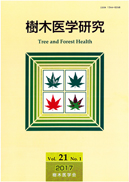Volume 10, Issue 2
Displaying 1-7 of 7 articles from this issue
- |<
- <
- 1
- >
- >|
-
2006Volume 10Issue 2 Pages App1-
Published: September 30, 2006
Released on J-STAGE: March 01, 2021
Download PDF (1735K)
Foreword
-
2006Volume 10Issue 2 Pages 61-62
Published: September 30, 2006
Released on J-STAGE: March 01, 2021
Download PDF (299K)
Article
-
2006Volume 10Issue 2 Pages 63-68
Published: September 30, 2006
Released on J-STAGE: October 01, 2020
Download PDF (972K)
Short Communication
-
2006Volume 10Issue 2 Pages 69-71
Published: September 30, 2006
Released on J-STAGE: October 01, 2020
Download PDF (348K)
Example from Practice
-
2006Volume 10Issue 2 Pages 73-76
Published: September 30, 2006
Released on J-STAGE: October 01, 2020
Download PDF (2240K)
Interpretive Article
-
2006Volume 10Issue 2 Pages 77-83
Published: September 30, 2006
Released on J-STAGE: March 01, 2021
Download PDF (1065K)
Symposium
-
2006Volume 10Issue 2 Pages 85-96
Published: September 30, 2006
Released on J-STAGE: March 01, 2021
Download PDF (2368K)
- |<
- <
- 1
- >
- >|
